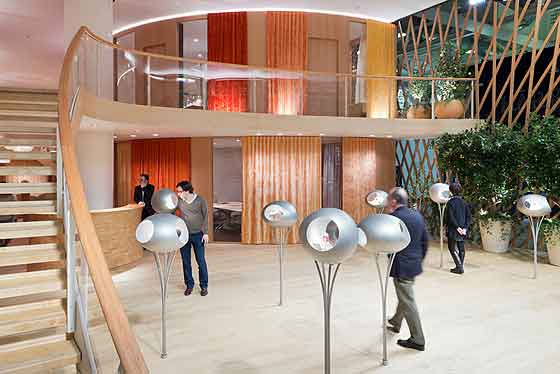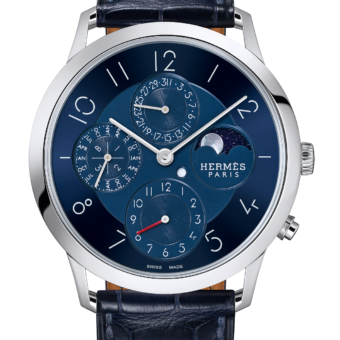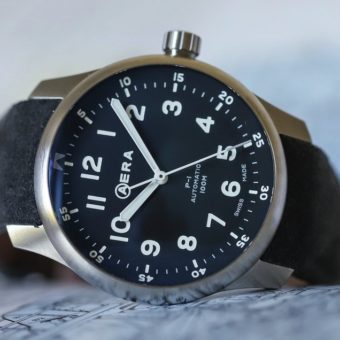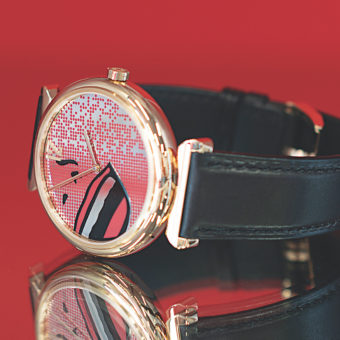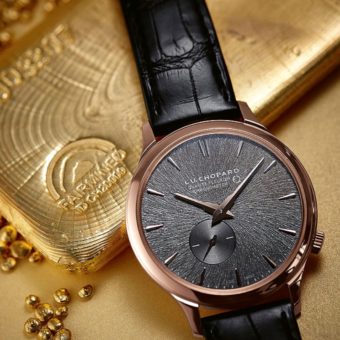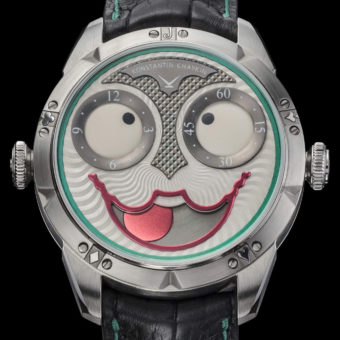
I spoke with Perramond recently at Hermès’s New York City headquarters to discuss the latest developments for the brand, including the debut of its first Dressage watch with an exclusive chronograph movement, and its plans for the future, in terms of technology, product development, and business strategy.
WT: How has your vertical integration strategy for La Montre Hermès progressed since the last time we spoke?
LP: I think we have made a lot of progress in the last five years in our strategy of mastering the watchmaking know-how by integrating the production for the key components, which are the watch cases, dials, and movements. Of course, the straps are already being made in-house. At this point, for some of the collection like the Dressage, we can say that 98% of the production cost of the watch is now in-house.
We are moving progressively towards a true manufacture, which has always been the philosophy of Hermès. If you look at all our product categories — leather, silk, all the major products — that is how they have been developed. We have always slowly mastered the know-how and integrated the craftsmanship. It is the same for the watch business: to ensure the best quality possible, and to guarantee that quality to your clients, you must at some point do it yourself. Also, we want to ensure our independence. The watch industry is getting more and more concentrated, and it’s important that we can secure this expertise in dials and cases in-house rather than contracting it to large [outside] groups. So we are progressing along this line, and sticking to this strategy, which is working well.
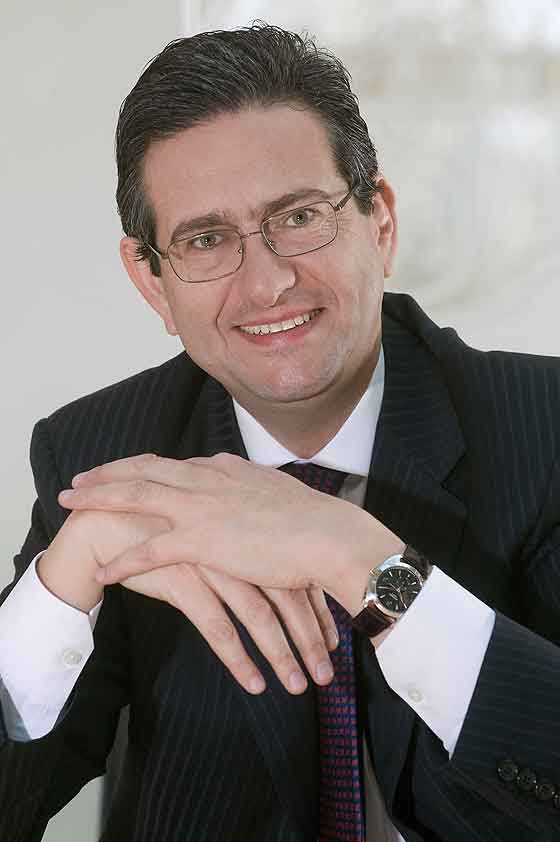
WT: Last year, Hermès introduced its first exclusive movement in a Dressage watch. And at this year’s Baselworld, the brand introduced a chronograph version of that watch — using the same base movement?
LP: After the launch of our first Dressage with a manufacture movement last year, we decided to add a complication, with a module, because this movement was always designed to be a base movement, an engine. It has double barrels, which gives it a power reserve of 50 hours and also improves the accuracy. The ideas was always to use this base caliber to develop a family of complications — the first one being, as you saw at Basel, a chronograph. Why? Quite simply, a chronograph is probably the most noble complication in the watch business, but also the most difficult to realize. We thought it would be a good extension of the Dressage family. At the same time, we wanted a chronograph that was not too massive, to keep the elegance of the Dressage line. We worked a lot on the thickness to keep it as thin as possible. So that’s a nice evolution, and there will be more coming. Our plan is to slowly extend the use of this movement in more collections.

WT: Right now, it’s only used in the Dressage?
LP: In the Dressage and part of the Arceau collection, the Le Temps Suspendu model for ladies. Two years ago, when we introduced the first Le Temps Suspendu in a 43-mm case, we used an ETA base movement because our own movement was not ready. But this new generation of Le Temps Suspendu is in a 38-mm case, suitable for small wrists, mostly for ladies. We worked with [independent watchmaker] Jean-Marc Wiederrecht to have the module set on our H1912 [ladies base] movement. Eventually, we hope to adapt it for the 43-mm case [and the H1837 movement] as well.
WT: Can you tell me anything about future complications you’re working on for the base movement? Are you working on several at once?
LP: When we do what we call a collection plan, we look at five years down the road. So we have to plan how we will introduce each new movement, with each new complication, in which collection. In the watch business, you need to build over the long term, so you have to be very careful about the pace of introduction. It’s too early to discuss specific complications, but you will see some that are traditional like our chronograph, but also some that are not conventional, like Le Temps Suspendu.
WT: Is Mr. Wiederrecht involved in any of the “unconventional” developments?
LP: He is with one of them, but we also work with other watchmakers, both independent and on our in-house team, on several concepts simultaneously, because it takes three to five years for such a concept to be realized and made reliable. Some projects will prove to be feasible, others will not. In Basel next year, you will see one of these new concepts.
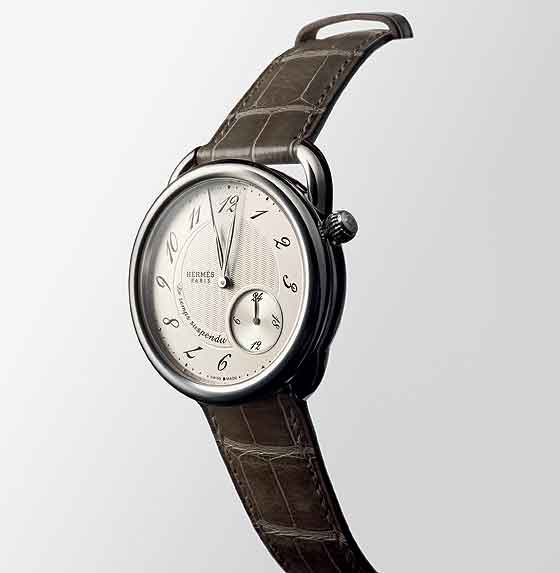
WT: Did the chronograph module that you integrated into the new Dressage come from your in-house watchmakers?
LP: No. Our team at Vaucher Manufacture [the movement factory in which Hermès holds an ownership stake] does not yet have the capability for the chronograph function — they only make the one that is proprietary to Parmigiani — so we worked very closely with Dubois Dépraz, which specializes in chronograph modules. We worked with them previously on moon-phase and other products. So together with Vaucher and Dubois-Dépraz, Hermès developed a module that could fit on our movement.
WT: Obviously, you’re making great strides with the movement development. In what other ways have you increased your vertical integration?
LP: Last year we integrated a historical supplier of dials called Nateber. They had been a supplier of ours for a very long time and they had no succession plan. It was important for us to ensure continuity, so we took over 100 percent of the company last year. We also took a majority share in another supplier, a casemaker called Joseph Erard. So we now have full control over these components. We have to outsource the crystal to a specialized manufacturer, but we assemble the full case in-house. So what’s left is really only the hands, and in this case we felt it was better to have a long-term partnership with a very well-known hands manufacturer in Switzerland. The economic reality of a hand manufacturer is that you need to produce millions of them in order to have a return on your investment, and we’re obviously not in the volume business.
WT: Are the watches’ Hermès leather straps made in France like other Hermès leather goods, or have you brought that expertise to Switzerland?
LP: We brought that expertise to Switzerland in 2006. Before then, straps were made in our workshops in France. Now we have a Swiss workshop with a team of leather makers who came from France, most of them from the handbag department. They’ve developed a special expertise for cutting and stitching the watch straps. We are the only watch company that does that in-house. (Click here to read our feature on Hermès’s leather strap-making process.)
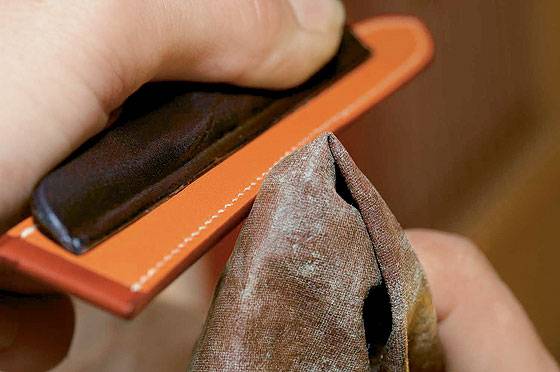
WT: What is the percentage breakdown now for men’s vs. ladies watches, as opposed to when you started?
LP: Five years ago, we had a mix that was unbalanced, about 80% ladies, and it was a key part of our strategy to rebalance and to capture more of the men’s, market, which we have — today men’s watches are 40% of our business. We doubled the share because we introduced more of the mechanical and more technical timepieces. The reception has been good, because Hermes is not really perceived as a feminine brand; we sell a lot of products to men — ties, shoes, watches, small leather bags, cuff links — about one third of our items.
WT: With the ladies’ watches, are you now focusing on shifting more of them to in-house mechanical movements as well?
LP: I wouldn’t say shifting, but we are increasing our ladies’ offerings in mechanicals. We’ve always said that we want to continue with quartz movements in the ladies’ collection because we can make these watches accessible to younger customers. But we have seen that, in a more sophisticated part of our client group, women have become more and more interested in mechanical movements, and for different reasons than men. Men will go for a mechanical watch because of the technical features in it, whereas women, in my opinion, appreciate that a movement is made in Switzerland, and that mechanical is a sign of authenticity. They know they are buying true craftsmanship; they know there is more substance in the watch compared to an electric watch with a battery.
I think there has been an over-saturation of pure industrial products in many categories, and in a way those objects have lost their soul because they lost the substance, which is the artisanal component, the hand-made art. People want to return to the ideas of authenticity, heritage, craftsmanship, and they are prepared to pay a premium for that. It’s true in many product categories, but it’s very true in watches.
WT: Is there a grand plan as to how much of the line you eventually see as having in-house mechanical movements, and has that plan accelerated or changed due to the situations in the watch industry, like ETA restricting movement sales?
LP: We do have to consider what’s happening in the industry, the fact that the supply of traditional mechanical movements will be smaller. At the same time, it fits our strategic objective, which is to do more ourselves. So it does accelerate the process, and eventually, most of our collections will be equipped with our own movements; it’s a natural evolution. It’s hard to say when or how much of the line, but it will be increasing every year.

WT: In which markets, and in what customer segments, do you see the most growth potential for Hermès watches?
LP: We have enjoyed in the last five years fast growth in some of our key markets like France, which is our largest market, but also in the U.S. and China; China has become one of the largest markets in a very short time. Now we need to pay attention to the future growth drivers, and for us, there are many, because we don’t yet have a complete network worldwide. There are markets that are almost virgin for us, such as Russia, where we have just introduced Hermès as a watch brand. Russia and all of the Eastern Europe countries will be important, as well as the Middle East. And now we have the right collection, the right products, for those markets — more mechanicals, more complications. Of course, I would include the U.S., because we are far from where we could be here in terms of size. Then you have some markets in Latin America — Mexico and Brazil mostly. And a very interesting development is the return of Japan. It went through a long recession, and an erosion of the luxury business, but last year and this year we’ve seen a fast expansion. Hermès has always been a powerful brand in Japan, and we’re seeing it come back very strongly.
In terms of the product, frankly the collections we offer are the same everywhere. It’s a pretty much a universal collection. Some countries and continents have preferences, so the mix may change slightly, but we don’t make products for certain countries. We make products that we feel suit the DNA of Hermès. Otherwise, it’s short-term thinking; you’re reacting to a demand instead of offering something that reflects who you are as a brand. It seems that our customers, whether they’re Japanese, Chinese, American or Italian, share an interest in those values. So I don’t imagine you’ll be seeing watches with dragons or U.S. flags, for example.
WT: You’ve emphasized that Hermès has actually been making watches for about 100 years and that you don’t regard it as a “fashion brand.” You’ve taken many steps to change that perception, but what are your peers and customers saying?
LP: What are you hearing? [Smiles.] It would be a bit arrogant for me to answer, but honestly I think people are seeing a change, that the perception is changing, albeit slowly. I think the industry is acknowledging it; winning the Grand Prix of Horology [in 2011] with Le Temps Suspendu was a leap forward; people in the industry began looking at us differently. What is more important to me are the opinion leaders — the press, the connoisseurs, the collectors, people who really appreciate watches — the ones we really have to work very hard to reach, to explain the changes and the sincere efforts we are making to establish ourselves as a watchmaker, like our investment in a new booth at this year’s Baselworld. Finally, one hopes, the end consumer will receive the message. Our numbers indicate that more and more people see these changes and appreciate them, because our average price has doubled in five years — about $5,000 now at retail compared to $2,000 five years ago. People are prepared to invest more in a Hermès watch. It’s a sign that people believe in what we’re doing. The message is getting across; there is a long way to go, but the watch business is a slow-moving business. Fashion is a fast business, with short cycles. We work in 10-year cycles and we believe we are doing it the right way.
